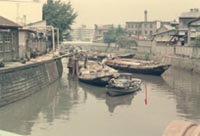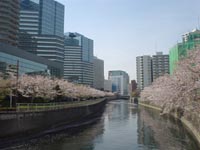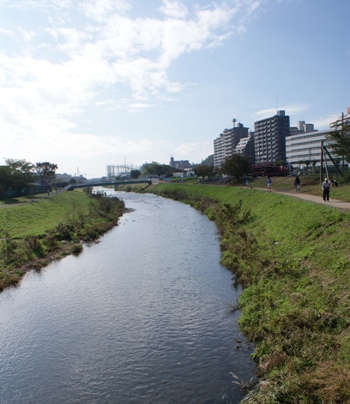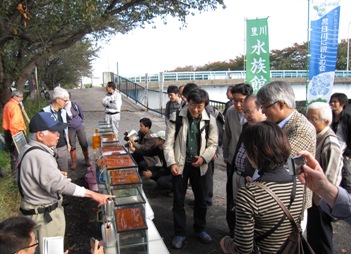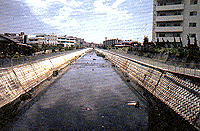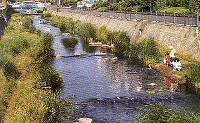
< World's WATERFRONT:JAPAN Category: Community and urban river restoration >
Before restoration (1972)
Source: Tokyo Metoropolitan Govt.
|
|
After restoration (2008)
Photo by Akira Wada, Aug. 2008
|
In watershed areas of Meguro River flowing through Tokyo, urbanization has been promoted since the Meiji Period, and the water quality was extremely deteriorated in the high-growth period. Then, bubbles of detergent floated on the water surface and unpleasant odors were produced over a long period. Later, the water quality and scenery were dramatically improved through the introduction of sewage systems and local citizens’ efforts.
However, there are many combined sewer systems in the watershed area of Meguro River even today, and there are some problems such as the river giving off a bad odor at times of flooding. Currently, various approaches aiming at water environment improvement such as releasing reclaimed sewage water and water purification experiments by using highly concentrated oxygen dissolution water are being conducted to restore the watershed areas where people can enjoy cherry-blossom viewing.
By JRRN-secre | Category: Community and urban river restoration,Kanto | Comment(0) | Trackback(0) |
Date: 2012.01.05 16:13
|
Movable aquarium by local citizen group
|
In the high-growth period, human sewage was fed into this river and the water quality was extremely deteriorated. In recent years, however, due to river improvement balancing flood control and environmental preservation with specific efforts for collaboration between citizens and administration in addition to improvement of the surrounding sewer network, the water quality and river environment has been improved greatly.
In the downstream area of Saitama Prefecture, this area is used as a water-attracting park because the bank protection work is small scale and the water-attracting qualities are high. In particular, in the downstream area in the north of Niiza City, many people enjoy fishing and the tranquil Musashino landscape is preserved as there is no residential area. In the upstream site of Higashikurume City, Tokyo, a cycling road has been built on either bank, where many people enjoy walking.
The Kurome River was awarded grand prix in the 5th “Iikawa & Iikawa-zukuri” workshop (old name: River’s day workshop in Japan) in Sep. 2012.
By JRRN-secre | Category: Community and urban river restoration,Kanto | Comment(0) | Trackback(0) |
Date: 2012.01.05 16:12
The Kokubun and Hayato areas lying on each side of Amori River were targeted in the "Kokubun, Hayato Technopolis plan" in March 1984 and river improvement work such as invitation of advanced technology developing companies was promoted.
For Amori River, which is an important water/green axis in this Kokubun, Hayato Technopolis district, a "hometown river model project" (the current hometown river improvement project) was started in June 1988 with the catch phrase of "From the past to the future, Amori River, a river of meetings and relaxation," while the water control safety degree between unimproved zones was raised. By taking advantage of the historical features from the age of myth and rich nature, the waterfront space has been improved to become a good place to meet people.
By JRRN-secre | Category: Community and urban river restoration,Kyushu | Comment(0) | Trackback(0) |
Date: 2011.09.10 19:00
Bachi River runs through the center of Kurosaki, flowing into Dokai Bay. In the past, people enjoyed fishing for crucian carps and children gathered and played at the waterfront. With the great flood damage in 1953 as a trigger, river improvement work to cast concrete in the three faces was conducted and the river became a drainage canal and was ignored by local residents.
Later, a river restoration project was started in 1995 and a research group was established to make best use of citizens' opinions. As a result of discussions with various parties concerned with the future of the river, the "Bachi River Renaissance Plan, Basic Concept" was drawn up.
Today, fireflies have returned to Bachi River and from 2006 on "Bachi River firefly festival" has been held. Bachi River won the "Handmade Hometown Award" in 2004.
By JRRN-secre | Category: Community and urban river restoration,Kyushu | Comment(0) | Trackback(0) |
Date: 2011.09.10 18:59
Aiba River is a 2.6km-long, 4m-wide small river, flowing east and west in the old samurai residential area in Hiyako, Emukai and Kawashima districts with the reminiscent atmosphere of a castle town. In the past there were indigo-dye shops operated by the clan on the riversides and the water was deep blue all over the river, thus this river was called Aiba (indigo-dye shop) River.
This river was used originally for supplying water for agriculture and daily living. In the middle of the Edo Period, the river was excavated so that ships could pass to transport firewood and coal.
Today, the water is still used for irrigation, disaster-prevention and daily living and the landscape and environment is conserved under a public-private partnership. As a canal, it is indispensable for civil life as a tourist spot of Hagi City, a castle town. It was designated as one of the best 100 canals in Japan and it won the "Handmade Hometown Award2 in 1988.
By JRRN-secre | Category: Community and urban river restoration,History and traditional restoration,Chugoku | Comment(0) | Trackback(0) |
Date: 2011.09.10 18:38
For Genbee River, citizens, companies and the government are working together on Genbee River Waterpark Project, by cleaning the environmental water and improving the recreational waterfront to recover the deteriorated waterfront environment. Citizens' groups clean the river periodically and release nymphs of fireflies into the river. As a result of these activities, a beautiful waterfront richly endowed with nature has been recovered.
Today, Genbee River is highly evaluated as a good case example in which a lost river has been recovered by citizens participating in urban development. It won the highest award of the "Civil Engineering Design Prize 2004, JSCE (Japan Society of Civil Engineers)" and “the Handmade Hometown Award" (local improvement section), City Landscape Award, "the Beautiful Town Award" in 2005 and the gold prize of "the Excellent Tourist Spot Creation Award” in 2006. Also it was designated as one of the 100 famous Heisei waters, 100 hometowns for nurturing water, greenery and culture and 100 best canals in Japan.
By JRRN-secre | Category: Community and urban river restoration,History and traditional restoration,Chubu | Comment(0) | Trackback(0) |
Date: 2011.09.10 18:33
In the "Azami-no-se" area of Matsuura River running through Matsuura County of Saga Prefecture, people have long suffered from flood damage. Therefore the retarding method has been adopted as the flood countermeasure instead of building embankments in this region and resident-participation projects to recover organisms in the valuable river environment and regenerate the contact between people and organisms are being promoted. As a result, a traditional fishing method has been revived and children have begun to play by the riverside again. In this way, the connection between people and nature has been regenerated.
By JRRN-secre | Category: Nature oriented restoration,Community and urban river restoration,Kyushu | Comment(0) | Trackback(0) |
Date: 2011.09.10 18:12
Tsurumi River basin was quite activated from the late 1960s with rapid city development, but it also came to have various problems such as flood control, environment, and disaster prevention. Given the situation that flood control safety level was hard to maintain, a committee of academic experts, basin local government, and river administrator was set to find a basin-wide solution for integration of river development and flood control measures. This is a pioneer of total flood control efforts in Japan. Beyond the basin measures such as rain runoff control, the local government’s urbanization plan and development projects were involved.
>>More details (PDF 54KB)
By JRRN-secre | Category: Community and urban river restoration,Kanto | Comment(0) | Trackback(0) |
Date: 2011.03.31 18:15
Before
(source: RFC)
|
|
After
(source: RFC)
|
In 1982, Yokohama City began developing shallow water channels along the Itachi River in order to restore the waterfront to its natural state. Prior to this, mudflats had developed as a result of earlier river improvement construction projects.
There were several goals to this river Restoration plan: to maintain sufficient water depth (i.e. to restore the water depth to pre-construction levels),to restore waterfront vegetation, to revive the riverbed microtopography in both rapid and slow streams, and to develop the river-walk. Through experimentation with various construction methods, the waterfront environment has now regained its natural vitality and once again attracts the local people.
>>More details (PDF 48KB)
By JRRN-secre | Category: Community and urban river restoration,Kanto | Comment(0) | Trackback(0) |
Date: 2011.03.31 18:10
In the peripheral area of No River flowing through Tokyo, a diversified environment consisting of springs, forests, wetlands and vegetation zones spread in the past. Today, however, the diversified natural environment has been damaged by the urbanization along the river and change of land use.
Nevertheless, a project is being conducted to regenerate the wetlands by using springs, create habitats or growing spaces for various organisms and provide a place for environmental education where people can commune with nature around No River Balancing Reservoir, which was constructed to prevent flooding.
By JRRN-secre | Category: Nature oriented restoration,Community and urban river restoration,Kanto | Comment(0) | Trackback(0) |
Date: 2010.09.10 18:03
<< Previous || Next >>
